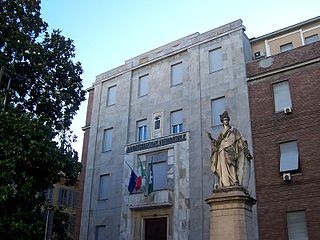| Castello d'Agogna | ||
|---|---|---|
| Comune | ||
| Comune di Castello d'Agogna | ||
| ||
| Coordinates: 45°14′N8°41′E / 45.233°N 8.683°E Coordinates: 45°14′N8°41′E / 45.233°N 8.683°E | ||
| Country | Italy | |
| Region | Lombardy | |
| Province | Pavia (PV) | |
| Government | ||
| • Mayor | Carlo Ercole Rolandi | |
| Area | ||
| • Total | 10.6 km2 (4.1 sq mi) | |
| Population (31 December 2004) [1] | ||
| • Total | 1,008 | |
| • Density | 95/km2 (250/sq mi) | |
| Demonym(s) | Castellanesi | |
| Time zone | CET (UTC+1) | |
| • Summer (DST) | CEST (UTC+2) | |
| Postal code | 27030 | |
| Dialing code | 0384 | |
| Patron saint | Santa Maria Bambina | |
| Saint day | September 8 | |
Castello d'Agogna is a small town and comune (municipality) in the Province of Pavia in the Italian region Lombardy, located about 45 km southwest of Milan and about 35 km west of Pavia. It is crossed by the Agogna river.

The comune is a basic administrative division in Italy, roughly equivalent to a township or municipality.

The province of Pavia is a province in the region of Lombardy in northern Italy; its capital is Pavia. As of 2015, the province has a population of 548,722 inhabitants and an area of 2,968.64 square kilometres (1,146.20 sq mi); the town of Pavia has a population of 72,205.

Italy, officially the Italian Republic, is a country in Southern and Western Europe. Located in the middle of the Mediterranean Sea, Italy shares open land borders with France, Switzerland, Austria, Slovenia and the enclaved microstates San Marino and Vatican City. Italy covers an area of 301,340 km2 (116,350 sq mi) and has a largely temperate seasonal and Mediterranean climate. With around 61 million inhabitants, it is the fourth-most populous EU member state and the most populous country in Southern Europe.
Contents
Castello d'Agogna borders the following municipalities: Ceretto Lomellina, Mortara, Olevano di Lomellina, Sant'Angelo Lomellina, Zeme.

Ceretto Lomellina is a comune (municipality) in the Province of Pavia in the Italian region Lombardy, located about 45 km southwest of Milan and about 40 km west of Pavia. As of 31 December 2004, it had a population of 228 and an area of 7.4 km².

Mortara is a town and comune in the region of Lombardy, Italy. It lies between the Agogna and Terdoppio rivers, in the historical district known as Lomellina, a rice-growing agricultural center. It received the honorary title of city with a royal decree in 1706.

Olevano di Lomellina is a comune (municipality) in the Province of Pavia in the Italian region Lombardy, located about 45 km southwest of Milan and about 35 km west of Pavia.









